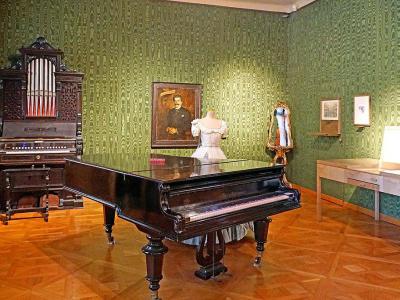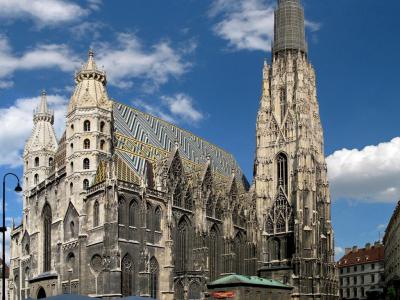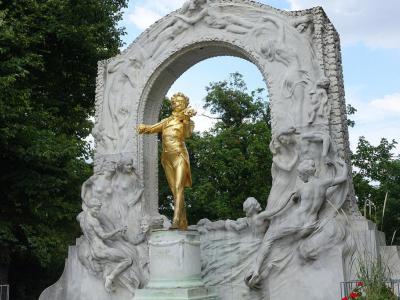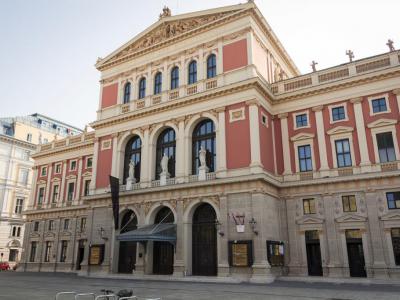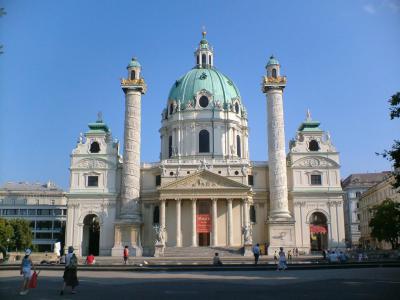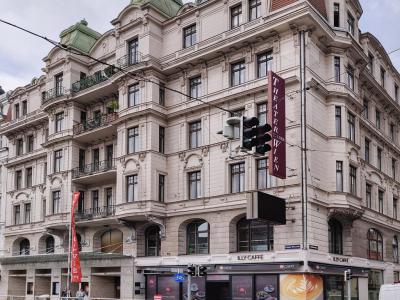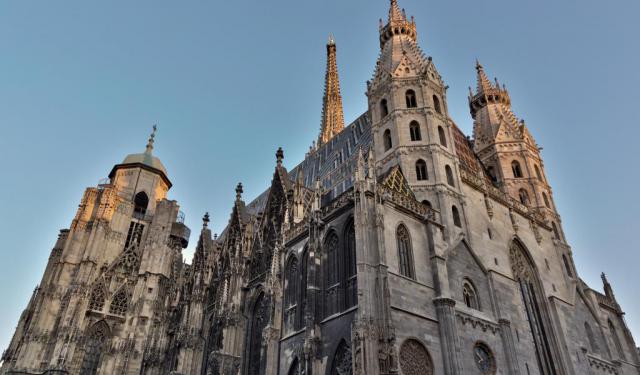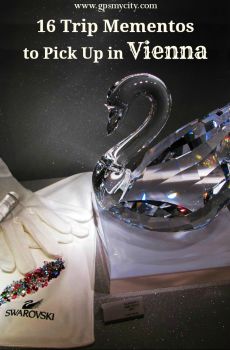
Johann Strauss Walking Tour (Self Guided), Vienna
Throughout the entire 19th century, Vienna was a hub of cultural and musical activity, particularly in the realm of classical music, to which Johann Strauss and his father, Johann Strauss Sr., contributed greatly.
Strauss, the son had a personal connection with Vienna deeply rooted in its cultural fabric. Not only was he born here and spent most of his life, but also he achieved tremendous success in this city. Often referred to as the "Waltz King," Strauss Jr. succeeded his father in this capacity and even surpassed him.
Vienna's vibrant social scene and extravagant balls provided a perfect backdrop for Strauss's music – his waltzes marvelously captured the essence of Viennese charm and elegance. Indeed, Strauss's compositions became synonymous with Vienna – the local elite and general public equally eagerly danced to and reveled in these joyful melodies.
There are several notable places in Vienna associated with Johann Strauss. One such is his apartment, at Praterstrasse 54, in which the composer lived from 1863 to 1878. It is now a museum.
Another significant landmark is the iconic Stephansdom or St Stephen's Cathedral. Here, the composer got married – twice!
Stadtpark (City Park) is home to the Johann Strauss Monument, a golden statue with a violin, capturing his charismatic presence. The prestigious Musikverein is where the Vienna Philharmonic Orchestra regularly performs the enchanting compositions of Strauss during the renowned New Year's Concert held in the Golden Hall.
Today, Strauss's legacy continues to thrive. His music – the embodiment of the spirit of Vienna – remains an enduring symbol of the Viennese tradition, earning Johann Strauss a place in the hearts of local citizens and music enthusiasts worldwide. If you wish to trace the footsteps of Strauss Jr. in the Austrian capital, follow this self-guided tour de force!
Strauss, the son had a personal connection with Vienna deeply rooted in its cultural fabric. Not only was he born here and spent most of his life, but also he achieved tremendous success in this city. Often referred to as the "Waltz King," Strauss Jr. succeeded his father in this capacity and even surpassed him.
Vienna's vibrant social scene and extravagant balls provided a perfect backdrop for Strauss's music – his waltzes marvelously captured the essence of Viennese charm and elegance. Indeed, Strauss's compositions became synonymous with Vienna – the local elite and general public equally eagerly danced to and reveled in these joyful melodies.
There are several notable places in Vienna associated with Johann Strauss. One such is his apartment, at Praterstrasse 54, in which the composer lived from 1863 to 1878. It is now a museum.
Another significant landmark is the iconic Stephansdom or St Stephen's Cathedral. Here, the composer got married – twice!
Stadtpark (City Park) is home to the Johann Strauss Monument, a golden statue with a violin, capturing his charismatic presence. The prestigious Musikverein is where the Vienna Philharmonic Orchestra regularly performs the enchanting compositions of Strauss during the renowned New Year's Concert held in the Golden Hall.
Today, Strauss's legacy continues to thrive. His music – the embodiment of the spirit of Vienna – remains an enduring symbol of the Viennese tradition, earning Johann Strauss a place in the hearts of local citizens and music enthusiasts worldwide. If you wish to trace the footsteps of Strauss Jr. in the Austrian capital, follow this self-guided tour de force!
How it works: Download the app "GPSmyCity: Walks in 1K+ Cities" from Apple App Store or Google Play Store to your mobile phone or tablet. The app turns your mobile device into a personal tour guide and its built-in GPS navigation functions guide you from one tour stop to next. The app works offline, so no data plan is needed when traveling abroad.
Johann Strauss Walking Tour Map
Guide Name: Johann Strauss Walking Tour
Guide Location: Austria » Vienna (See other walking tours in Vienna)
Guide Type: Self-guided Walking Tour (Sightseeing)
# of Attractions: 6
Tour Duration: 2 Hour(s)
Travel Distance: 4.1 Km or 2.5 Miles
Author: leticia
Sight(s) Featured in This Guide:
Guide Location: Austria » Vienna (See other walking tours in Vienna)
Guide Type: Self-guided Walking Tour (Sightseeing)
# of Attractions: 6
Tour Duration: 2 Hour(s)
Travel Distance: 4.1 Km or 2.5 Miles
Author: leticia
Sight(s) Featured in This Guide:
- Johann Strauss Apartment
- Stephansdom (St. Stephen's Cathedral)
- Johann Strauss Monument
- Musikverein (Vienna Philharmonic)
- Karlskirche (St. Charles' Church)
- Theater an der Wien (Opera House)
1) Johann Strauss Apartment
Fans of the Waltz King should head for the apartment on the first floor of Praterstraße no. 54 where the composer lived from 1863 until the death of his first wife, the glamorous opera singer Jetty Treffz, in 1878. It was there, under the high ceilings, that he composed "The Blue Danube", Austria's unofficial anthem, despite his father's attempts to drag him out of the music business and to hinder his musical pursuits.
The apartment has (German/English) displays of Strauss' original furnishings and instruments, with visitors able to get glimpses into the man, the composer, the conductor, the caricaturist, and the card player. One room, decorated with ceiling panels of cherubs, contains his grand piano, house organ and standing desk at which he used to compose. There's also a fascinating collection of ballroom memorabilia, including an Amati violin, gimmicky dance cards and quirky ball pendants, kept as mementos of the evening. Oil paintings from Strauss' last apartment, which was destroyed during WWII, are also on site.
Tip:
As you enter the first room, wave at the sensor hidden under the title-page display until "The Blue Danube" starts to play.
The apartment is not to be confused with the Strauss Museum, which instead explicates the entire Strauss musical family.
The apartment has (German/English) displays of Strauss' original furnishings and instruments, with visitors able to get glimpses into the man, the composer, the conductor, the caricaturist, and the card player. One room, decorated with ceiling panels of cherubs, contains his grand piano, house organ and standing desk at which he used to compose. There's also a fascinating collection of ballroom memorabilia, including an Amati violin, gimmicky dance cards and quirky ball pendants, kept as mementos of the evening. Oil paintings from Strauss' last apartment, which was destroyed during WWII, are also on site.
Tip:
As you enter the first room, wave at the sensor hidden under the title-page display until "The Blue Danube" starts to play.
The apartment is not to be confused with the Strauss Museum, which instead explicates the entire Strauss musical family.
2) Stephansdom (St. Stephen's Cathedral) (must see)
With its intricately patterned tiled roof, the imposing Gothic cathedral of Saint Stephen's (Stephansdom) is a prime landmark inside Vienna's old city center, having stood watch over the place for nearly 700 years. Its distinctive south tower rises to an impressive 445 feet and previously has served as the main observation and command post for the city's walled defense, for which purpose it even contained an apartment for watchmen who, until 1955, manned the tower at night and rang the bells if a fire was spotted. There was to be a twin north tower, but for several reasons, it ended up being just half the size and of a different design.
The views from the Watch Room, at the top, are surely worth climbing the 343 steps, otherwise you can take a lift up to a viewing platform on the shorter tower, home to the massive Pummerin ("Boomer") Bell – the largest in Austria, originally cast from melted-down cannons abandoned by the Turks while fleeing Vienna in 1683.
High points of the interior are the gorgeous vaulting of the Albertine Chapel, the stone pulpit (a masterwork of late Gothic sculpture), canopies or baldachins over many of the side altars, and a most spectacular Renaissance work – Friedrich III's tomb. You also won't want to miss the 14th century catacombs and the treasury where some of the cathedral's most valuable objects are displayed. Some of them can only be seen on a guided tour, such as a red marble sepulcher sculpted in 1467-1513, the 16th-century pulpit, a Gothic winged altar from the 1440s, and the tomb of Prince Eugene of Savoy dated 1754.
Visit Saint Stephen's Cathedral and you'll be standing in the same church in which Joseph Haydn once sang as a choir boy until his voice broke, and where Johann Strauss married both of his wives, Henrietta Treffz and Angelika Dittrich. A memorial tablet gives a detailed account of Wolfgang Amadeus Mozart's relationship with the cathedral, including that of him being appointed an adjunct music director here shortly before his death. This was his parish church when he lived at the Figaro House and he was married here; two of his children were also baptized at Saint Stephen's, and his funeral was held in the Chapel of the Cross inside.
Why You Should Visit:
While incredible architecture is rather commonplace in Vienna, this majestic Roman-Gothic masterpiece is absolutely unmistakable and not to be missed.
Tip:
Be sure to make a loop around the structure as there are many interesting details still visible on the outside walls.
The views from the Watch Room, at the top, are surely worth climbing the 343 steps, otherwise you can take a lift up to a viewing platform on the shorter tower, home to the massive Pummerin ("Boomer") Bell – the largest in Austria, originally cast from melted-down cannons abandoned by the Turks while fleeing Vienna in 1683.
High points of the interior are the gorgeous vaulting of the Albertine Chapel, the stone pulpit (a masterwork of late Gothic sculpture), canopies or baldachins over many of the side altars, and a most spectacular Renaissance work – Friedrich III's tomb. You also won't want to miss the 14th century catacombs and the treasury where some of the cathedral's most valuable objects are displayed. Some of them can only be seen on a guided tour, such as a red marble sepulcher sculpted in 1467-1513, the 16th-century pulpit, a Gothic winged altar from the 1440s, and the tomb of Prince Eugene of Savoy dated 1754.
Visit Saint Stephen's Cathedral and you'll be standing in the same church in which Joseph Haydn once sang as a choir boy until his voice broke, and where Johann Strauss married both of his wives, Henrietta Treffz and Angelika Dittrich. A memorial tablet gives a detailed account of Wolfgang Amadeus Mozart's relationship with the cathedral, including that of him being appointed an adjunct music director here shortly before his death. This was his parish church when he lived at the Figaro House and he was married here; two of his children were also baptized at Saint Stephen's, and his funeral was held in the Chapel of the Cross inside.
Why You Should Visit:
While incredible architecture is rather commonplace in Vienna, this majestic Roman-Gothic masterpiece is absolutely unmistakable and not to be missed.
Tip:
Be sure to make a loop around the structure as there are many interesting details still visible on the outside walls.
3) Johann Strauss Monument
The gilded bronze tribute to the Waltz King is easily one of the most known and most frequently photographed monuments in Vienna – including after dark when beautifully illuminated. Compared to the many traditional 19th-century-style statues at Stadtpark, this certainly is a more playful, elegant and interesting composition to view. Framed by a marble relief made by founding member of the Vienna Secession, Edmund Hellmer, it was unveiled to the public on 26 June 1921.
The statue is located right behind the opulent Kursalon concert hall where Strauss Jr. gave his first concert on 15 October 1868, turning it into a popular place for concerts and for dancing ever since. After undergoing some renovation, the Kursalon is still used for balls and waltz concerts where one can hear the composer's music.
Tip:
Scattered throughout the park are other statues of famous Viennese artists, writers, and composers: Hans Canon, E. J. Schindler, Franz Schubert, Anton Bruckner.
The statue is located right behind the opulent Kursalon concert hall where Strauss Jr. gave his first concert on 15 October 1868, turning it into a popular place for concerts and for dancing ever since. After undergoing some renovation, the Kursalon is still used for balls and waltz concerts where one can hear the composer's music.
Tip:
Scattered throughout the park are other statues of famous Viennese artists, writers, and composers: Hans Canon, E. J. Schindler, Franz Schubert, Anton Bruckner.
4) Musikverein (Vienna Philharmonic)
Two concert halls in one building, designed in the 1860s with dazzling gilding inside. The larger of the two, the Grosser Saal ("Great Hall"), has some of the best acoustics in the world – along with Berlin's Konzerthaus, the Concertgebouw in Amsterdam, and Boston's Symphony Hall – and is the unofficial home of the great Vienna Philharmonic Orchestra, which gives regular sell-out performances, while the other hall, the Brahms Saal, is used for smaller-scale chamber concerts.
The Musikverein's most prestigious event is the annual New Year's Day concert, a tradition started under the Nazis in 1939, and one which is now broadcast live around the world to an estimated 50 million viewers from 95 countries. If you are lucky to be in Vienna during the regular season (September-June), go for a real concert instead of a tourist-oriented one. While tickets for "proper" concerts may be sold out months in advance, other times they will be on sale up to the start of the performance. In any case, use the official box office on the left side of the building or the official website, as agencies are known to take a hefty commission.
The concert hall itself also has a rich musical history, as the place where Johann Strauss Jr. personally conducted the waltz "Freut Euch des Lebens" (Life Let Us Cherish – composed for the opening ball), and where Arnold Schönberg unleashed atonal music – or as Schönberg preferred to call it, "the emancipation of dissonance" – on an unsuspecting and unready Viennese public.
Why You Should Visit:
The building is intricately beautiful and the guided tour, fascinating.
The area itself is very happening so you should be checking it out.
Tip:
One must enter a computer lottery to win the chance to buy tickets for events, but it is well worth the effort.
One could also get a (cheaper) last-minute standing room ticket if one tries.
The Musikverein's most prestigious event is the annual New Year's Day concert, a tradition started under the Nazis in 1939, and one which is now broadcast live around the world to an estimated 50 million viewers from 95 countries. If you are lucky to be in Vienna during the regular season (September-June), go for a real concert instead of a tourist-oriented one. While tickets for "proper" concerts may be sold out months in advance, other times they will be on sale up to the start of the performance. In any case, use the official box office on the left side of the building or the official website, as agencies are known to take a hefty commission.
The concert hall itself also has a rich musical history, as the place where Johann Strauss Jr. personally conducted the waltz "Freut Euch des Lebens" (Life Let Us Cherish – composed for the opening ball), and where Arnold Schönberg unleashed atonal music – or as Schönberg preferred to call it, "the emancipation of dissonance" – on an unsuspecting and unready Viennese public.
Why You Should Visit:
The building is intricately beautiful and the guided tour, fascinating.
The area itself is very happening so you should be checking it out.
Tip:
One must enter a computer lottery to win the chance to buy tickets for events, but it is well worth the effort.
One could also get a (cheaper) last-minute standing room ticket if one tries.
5) Karlskirche (St. Charles' Church)
Vienna's Karlskirche (Saint Charles' Church) is located in the eponymous Karlsplatz (Saint Charles' Square), about 200 meters away from Ringstrasse, and is one of the finest examples of Baroque religious architecture in the city. Among its prominent features are the impressive oval high ceiling dome topping the structure, the elongated form of the building, and the exterior columns modeled on the famous analogues in Rome dedicated to the Emperor Trajan. The Viennese columns celebrate the life of Saint Charles Borromeo (to whom the church is dedicated) and the vast power of the Hapsburgs, symbolizing the Pillars of Hercules. Another interesting feature are the two spheres with metallic reflective sides allowing viewers to observe more details of the interior.
In recent times, the location has become a very popular tourist attraction, in large part due to its peculiar style, starkly contrasting that of other buildings nearby. Saint Charles' is run by a local Catholic order and remains a parish church. It is also seat of the Catholic student ministry of the Vienna University of Technology and thus, apart from being an architectural marvel, is a functional institution.
Erected to celebrate the emergence from black plague that struck Vienna hard in the early 18th century, the Karlskirche is virtually a monument to Saint Charles Borromeo who was renowned for ministering to the needs of plague victims. History tells that Emperor Charles VI made a vow to God that he would build a church and name it after Saint Charles Borromeo, if God relieved the city of the disease. God did, and so did the Emperor.
*****Johann Strauss Walk*****
On May 28, 1878 Strauss married his second wife, a young singer named Angelika Dittrich, at Saint Charles' Church. Unfortunately, Dittrich was not a supporter of his music and their marriage ended in divorce in 1882.
Tip:
You have to pay to get in (students get a discount), but it's well worth it for the lovely interior.
There is a lift inside that can take you close to the murals on the dome ceiling. From up there, you can also enjoy a spectacular view of the city from the dome window.
In recent times, the location has become a very popular tourist attraction, in large part due to its peculiar style, starkly contrasting that of other buildings nearby. Saint Charles' is run by a local Catholic order and remains a parish church. It is also seat of the Catholic student ministry of the Vienna University of Technology and thus, apart from being an architectural marvel, is a functional institution.
Erected to celebrate the emergence from black plague that struck Vienna hard in the early 18th century, the Karlskirche is virtually a monument to Saint Charles Borromeo who was renowned for ministering to the needs of plague victims. History tells that Emperor Charles VI made a vow to God that he would build a church and name it after Saint Charles Borromeo, if God relieved the city of the disease. God did, and so did the Emperor.
*****Johann Strauss Walk*****
On May 28, 1878 Strauss married his second wife, a young singer named Angelika Dittrich, at Saint Charles' Church. Unfortunately, Dittrich was not a supporter of his music and their marriage ended in divorce in 1882.
Tip:
You have to pay to get in (students get a discount), but it's well worth it for the lovely interior.
There is a lift inside that can take you close to the murals on the dome ceiling. From up there, you can also enjoy a spectacular view of the city from the dome window.
6) Theater an der Wien (Opera House)
Splendid architecturally, well organized, and with a program of shows that hosts the most important artists in Europe year-round, Vinenna's oldest standing theater is a pleasure for tourists. You can read interviews with singers who say that they love it, too, because of its intimacy and the way its acoustics show off the voice.
Theater an der Wien was opened in 1801; a statue above the original Millöckergasse entrance (around the corner from the present main entrance) shows its founder, Emanuel Schikaneder, playing Papageno in Mozart's "The Magic Flute". The building is also closely linked to Beethoven, who lived here while working on "Fidelio" (his only opera, celebrating the triumph of marital love and female heroism over the cruelty of official tyranny), but also to Johann Strauss Jr, whose operetta "Die Fledermaus" was premiered on 5 April 1874 and has been part of the regular repertoire ever since.
The spirit of musical history probably adds to one's enjoyment, but the performances one sees here – including daring performances of 20th- and 21st-century works – are wonderful in themselves: imaginative and effective staging, fine orchestras and choruses, and exceptional singers. Tours of the foyer, auditorium, and stages (with a sneak peek into the cloakrooms and mask collection) sold at the box office cost €7 per person and are a wonderful way to get the entire history and see backstage areas.
Theater an der Wien was opened in 1801; a statue above the original Millöckergasse entrance (around the corner from the present main entrance) shows its founder, Emanuel Schikaneder, playing Papageno in Mozart's "The Magic Flute". The building is also closely linked to Beethoven, who lived here while working on "Fidelio" (his only opera, celebrating the triumph of marital love and female heroism over the cruelty of official tyranny), but also to Johann Strauss Jr, whose operetta "Die Fledermaus" was premiered on 5 April 1874 and has been part of the regular repertoire ever since.
The spirit of musical history probably adds to one's enjoyment, but the performances one sees here – including daring performances of 20th- and 21st-century works – are wonderful in themselves: imaginative and effective staging, fine orchestras and choruses, and exceptional singers. Tours of the foyer, auditorium, and stages (with a sneak peek into the cloakrooms and mask collection) sold at the box office cost €7 per person and are a wonderful way to get the entire history and see backstage areas.
Walking Tours in Vienna, Austria
Create Your Own Walk in Vienna
Creating your own self-guided walk in Vienna is easy and fun. Choose the city attractions that you want to see and a walk route map will be created just for you. You can even set your hotel as the start point of the walk.
Klimt Paintings Tour
"I have the gift of neither the spoken nor the written word, especially if I have to say something about myself or my work. Whoever wants to know something about me - as an artist, the only notable thing - ought to look carefully at my pictures" – Gustav Klimt.
Klimt's name is indelibly linked to Vienna. The renowned symbolist painter was a prominent figure in the city. As a... view more
Tour Duration: 2 Hour(s)
Travel Distance: 3.7 Km or 2.3 Miles
Klimt's name is indelibly linked to Vienna. The renowned symbolist painter was a prominent figure in the city. As a... view more
Tour Duration: 2 Hour(s)
Travel Distance: 3.7 Km or 2.3 Miles
Vienna Introduction Walking Tour I
A city of green parks, opulent architecture, elegant shopping, crowded theaters, and boulevards for leisurely sauntering — Austria's capital Vienna is rightfully regarded as one of the most beautiful cities in Europe. The origin of its name is subject to a debate in which, some say, it came from vedunia ("forest stream"), which subsequently produced the New High German “wien”... view more
Tour Duration: 2 Hour(s)
Travel Distance: 1.8 Km or 1.1 Miles
Tour Duration: 2 Hour(s)
Travel Distance: 1.8 Km or 1.1 Miles
Vienna's Historical Music Venues
Austria is synonymous with classical music almost to the point of obsession, and to call Vienna the "Musical Capital of the World" would be hardly an exaggeration. Indeed, over the past centuries, the city served as the home and workplace for many great musicians like Wolfgang Amadeus Mozart, Ludwig van Beethoven, Johann Strauss, Joseph Haydn, Franz Schubert, and others.
Among the... view more
Tour Duration: 2 Hour(s)
Travel Distance: 3.0 Km or 1.9 Miles
Among the... view more
Tour Duration: 2 Hour(s)
Travel Distance: 3.0 Km or 1.9 Miles
Vienna Old Town Walking Tour
Encircled by the grand Ringstrasse, otherwise known as the Ring, the historic Old Town of Vienna (Innere Stadt) is a designated World Heritage Site.
At the heart of it all lies Saint Stephen's Square (Stephansplatz), a bustling hub surrounded by iconic landmarks and vibrant street life.
Mozarthaus, once home to the legendary composer Wolfgang Amadeus Mozart, is a delightful stop for... view more
Tour Duration: 2 Hour(s)
Travel Distance: 2.9 Km or 1.8 Miles
At the heart of it all lies Saint Stephen's Square (Stephansplatz), a bustling hub surrounded by iconic landmarks and vibrant street life.
Mozarthaus, once home to the legendary composer Wolfgang Amadeus Mozart, is a delightful stop for... view more
Tour Duration: 2 Hour(s)
Travel Distance: 2.9 Km or 1.8 Miles
Vienna's Art Nouveau Architecture Tour I
Among the plethora of other things, the capital of Austria, Vienna, is renowned for its contribution to Art Nouveau – the popular art movement emerged and flourished at the turn of the 20th century. Stemming from it the Viennese Secession movement, also known as the Austrian Art Nouveau, or Jugendstil (in German), gave rise to a number of architectural marvels.
By far the most colorful of... view more
Tour Duration: 2 Hour(s)
Travel Distance: 3.4 Km or 2.1 Miles
By far the most colorful of... view more
Tour Duration: 2 Hour(s)
Travel Distance: 3.4 Km or 2.1 Miles
Old Town Churches Walking Tour
"Vienna is the city of miracles and music" – Whoever said that must have emphasized Vienna's close association with the Christian faith. The intertwining of Christian heritage and artistry in the Austrian capital finds expression primarily in its magnificent churches.
Sitting at "the crossroads of Christian traditions", Vienna is home to various Christian... view more
Tour Duration: 2 Hour(s)
Travel Distance: 3.9 Km or 2.4 Miles
Sitting at "the crossroads of Christian traditions", Vienna is home to various Christian... view more
Tour Duration: 2 Hour(s)
Travel Distance: 3.9 Km or 2.4 Miles
Useful Travel Guides for Planning Your Trip
Top 16 Austrian Things to Buy in Vienna
Vienna stool, Viennese schnitzel, Viennese waltz, Vienna sausage, Viennese apple strudel... There's so much Vienna to it, that you might think you've heard it all. Luckily, chances are that you haven't and there's much more in store left to be discovered about this fascinating...
7 Ultimately Austrian Foods to Taste in Vienna
Once the center of the vast Hapsburg Empire, stretched from France in the West to Russia in the East, Austria has embraced many ethnic influences in its cuisine over the course of centuries. Many of the country's distinctive dishes reflect its multinational heritage. Coffee culture, for...
The Most Popular Cities
/ view all
